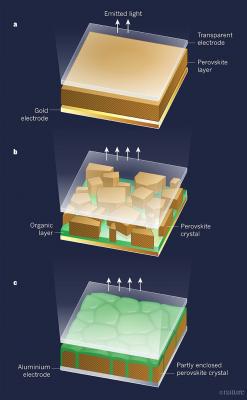Two papers have recently been published, reporting on perovskite-based LEDs. The efficiencies with which some perovskite LEDs (PLEDs) produce light from electrons already seem to rival those of OLEDs.

Both papers, by Cao et al. and Lin et al., have developed PLEDs that break an important technological barrier: the external quantum efficiency (EQE) of the devices, which quantifies the number of photons produced per electron consumed, is greater than 20%. There are several similarities between the devices reported by the two groups. Perhaps most notably, the active (emissive) perovskite layer is about 200 nanometres thick in both cases, and is sandwiched between two relatively simple electrodes. This design is called a planar structure, and is the most basic manifestation of diodes made from thin films of materials. The electrodes are appropriately modified to ensure that electrons and holes (quasiparticles formed by the absence of electrons in atomic lattices) are efficiently pumped into the perovskite. As in all LEDs, when electrons meet holes, they can release energy in the form of photons through a process known as radiative recombination.
Achieving high EQEs in any LED requires the elimination of non-radiative losses, as electron'hole-recombination pathways do not produce photons. Both Cao and colleagues' and Lin and colleagues' PLEDs deliver on this equally well. But the two groups also used other, subtly different methods to improve the EQE.
Cao et al. targeted the outcoupling problem, which is well known in the realm of thin-film LEDs (like PLEDs and OLEDs). The outcoupling problem is that the optical physics of planar diodes causes 70'80% of the light generated by the semiconductor to be trapped in the device.
Cao and colleagues took a simple approach to this issue: they optimized their perovskite-processing conditions so that the emissive layer spontaneously forms as distinct submicrometre-scale crystal platelets. The authors' computational modelling shows that this submicrometre structuring increases the fraction of light that makes it out of the emissive layer to 30%, compared with 22% for an equivalent 'flat-layer' perovskite device (a device in which the perovskite layer does not have submicrometre structuring). In combination with the reduction in non-radiative losses, this results in an EQE of 20.7%.
By contrast, Lin et al. used a flat emissive layer, but tried to optimize the balance of electrons and holes injected into the perovskite, to make the most efficient use of every charge. This seems to be facilitated by the MABr shells that enclose the perovskite crystals. The resulting PLEDs have an EQE of 20.3%.
It is, however, important to point out that OLEDs, and in fact all optoelectronic devices based on organic semiconductors, suffered for many years from stability issues. The first polymer OLEDs could emit light for only seconds, and subsequent advances were needed to ensure that smartphone screens and OLED televisions last for tens of thousands of hours. The lifetime of LEDs can be measured by the T50 metric, which is the time for the performance of the device to drop by half. The T50 values of Cao and colleagues' and Lin and colleagues' PLEDs are currently modest: 20 hours and 100 hours, respectively.
Moreover, displays require a minimum of three colors (and preferably more) to create high-quality color images. Developing a range of colors for OLEDs was a big challenge. Cao and co-workers' PLEDs emit in the near-infrared region of the electromagnetic spectrum, and Lin and co-workers' PLEDs emit green light ' which is a good start. Multiple colors of PLEDs could be generated by altering the composition of the devices, but the same developmental journey as was needed for OLEDs probably lies ahead.
The two papers also highlight problems that occur every time new optoelectronic materials emerge as a technological platform: inconsistent characterization and a lack of standards. Because Cao and colleagues' PLEDs emit light from outside the visible spectrum, they report the metrics of their devices radiometrically ' they use a measure that simply takes into account the total emitted power. By contrast, Lin and colleagues describe the emission of their green PLED using photometric measures, which are weighted by the response of the human eye. The two groups also report the peak EQEs at different brightnesses, and therefore at different driving currents. This makes direct comparison somewhat problematic.

